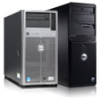Dell PowerEdge M820 Technical Guide - Page 29
Environmental specifications
 |
View all Dell PowerEdge M820 manuals
Add to My Manuals
Save this manual to your list of manuals |
Page 29 highlights
Thermal control also detects and responds to hardware configuration. Thermal management adjusts cooling according to what the system really needs, and draws lower fan power draw and generates lower acoustical noise levels than those without such controls. Environmental specifications: The optimized thermal management makes the PowerEdge M820 reliable under a wide range of operating environments as shown in Table 24. The acoustical performance of the PowerEdge M820 is reflected in Table 16. The addition of some components can cause an increase in fan speed and acoustical output. Contributors to acoustical output can include: The system thermal profile selected in BIOS (for example, Power optimized DAPC or Performance optimized) NDC Number of installed processors Population of modular, non-homogenous modular deployment Impedance of blanks Configuration (23 ± 2°C ambient) CPUs Minimum 2 x 95W (6 core) Hard drives 1 x 2.5" SATA (7.2K) DIMMs HDD controller NDC PCI cards Operating mode 2 x 2GB PERC H310 (mini) None Any mezz. card Standby3 Idle4 LWA-UL1 (bels) 6.9 7.4 LpA2 (dBA) 51 55 Typical 2 x 95W (8 core) 2 x 2.5" SAS (10K) 16 x 8GB PERC H710 (mini) 1Gb Any mezz. card Standby3 Idle4 6.9 7.3 52 55 1LWA-UL is the upper limit sound power levels (LWA) calculated per section 4.4.1 of ISO 9296 (1988) and measured in accordance to ISO 7779 (2010). 2LpA is the average A-weighted sound pressure level of four bystanders in accordance with ISO 7779 (2010) Section 8.6.2. The system is placed inside 42U rack in 25cm height. 3Standby: AC Power is connected to power supply units but the system is not turned on. 4Idle: Reference ISO 7779 (2010) definition 3.1.7; system is running in its operating system but no other specific activity. Note: Stress is an operating mode per ISO 7779 (2010) definition 3.1.6. Since blade stressing applications vary widely, blade stress values are not available. 29 PowerEdge M820 Technical Guide















